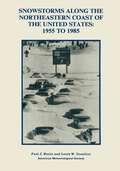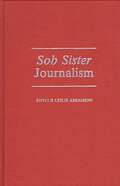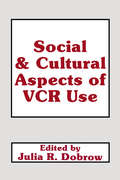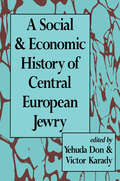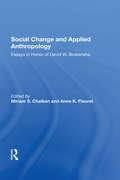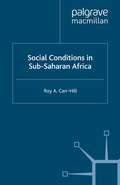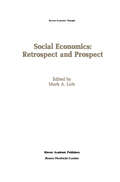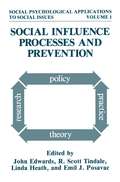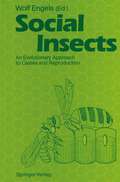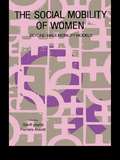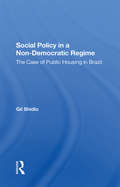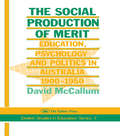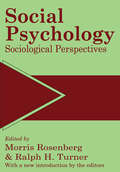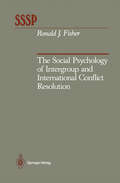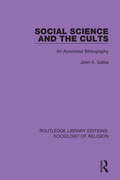- Table View
- List View
Snack Food
by R. Gordon BoothRather than containing for the most part fairly detailed food science and technology intended for daily use and reference by food scientists and technologists, this book is designed for use by a much wider range of readers concerned with a particular and rapidly expanding area of food production, promotion, marketing, and packaging. A certain amount of basic detail is provided to enable relatively rough estimates of the production methods and packaging facilities necessary to enable new or improved items to be made, but the overall emphasis is on the wide range of food products that can now quite legitimately be regarded as coming within the broad definition of foods used as snacks, as contrasted with main meals. Thus, we start with the basic requirements to be met in a snack food whatever its nature, and follow with the great variety of items nowadays used 3..'l snacks or as adjuvants to snacks, concluding with an assessment of nutritional consequences of the growth of "snacking" or "browsing," and with the special packaging requirements of snack foods.
The Snowman Storybook
by Raymond BriggsThe evocative story of a small boy's friendship with a snowman and their flight together over the sparkling winter landscape. Originally told without words through Raymond Briggs' gentle, atmospheric pictures, and told in this version in words by the artist, the book is about the innocence and wonder of childhood.
Snowstorms Along the Northeastern Coast of the United States: 1955 to 1985 (Meteorological Monographs)
by Paul J. Kocin Louis Uccellinisnowstorms along the Northeastern Coast of the United States: 1955 to 1985 documents 20 of the most crippling snowstorms that have affected the heavily populated coastal region of the Middle Atlantic states and southern New England over the last four decades. Heavy snowfall and high winds associated with storms often referred to as "nor'easters" can maroon millions of people at home or in transit, severely disrupt human services and commerce, and endanger the lives of those who venture out doors. Paul J. Kocin and Louis W. Uccellini provide answers to questions of how these important storms develop, what factors delineate snow/no snow situations, and what weather patterns provide clues that foretell such events. The book provides a comprehensive overview of this phenomenon from historical, climatological, and dynamical perspectives, using many illustrations, maps, tables, and color schematics. The introduction describes the major effects of such storms, the complex physical interactions that fuel their development, and the problems they present to forecasters trying to predict their fickle behavior and progress. A review of the great northeastern storms of the past three centuries follows, along with a climatology of the heavy snow events over a 30-year period. Descriptions of 20 major storms supply a framework for understanding the dynamical and thermodynamical processes that contribute to heavy snowfall. A summary of the physical processes that contribute to the storms concludes with issues that remain to be resolved. The case-study approach presents a great deal of material contained in hundreds of synoptic analyses in a well-organized and useful layout, allowing case-by-case comparisons of common features and differences. Extensive tables, diagrams, and photographs show weather patterns at the surface and aloft, emphasizing cyclone tracks and deepening rates, the contributions of cold surface anticyclones, cold-air damming and coastal frontogenesis, upper-level processes, jet streak circulations, satellite imagery, and three-dimensional air flow. It is hoped that this book will provide a foundation for researchers and students interested in investigating the processes that interact to produce major winter storms. The weather patterns described here provide a first step in the generation of conceptual models, and also serve as an easily referenced guide for forecasters concerned with predicting heavy snowfalls along the northeastern coast of the United States.
Sob Sister Journalism (Contributions to the Study of Mass Media and Communications)
by Phyllis AbramsonOn June 25, 1906 an event of little public importance occurred. Fueled by popular mood and climate, and capitalized upon by the press, it became the hottest story of the century. Phyllis Leslie Abramson's book recreates the social, political, and economic climate; the murder; and the subsequent trial that led to the manifestation of sob sister journalism. The story was prosaic: an insanely jealous man murdered his wife's lover. The protagonists were front-page material: Stanford White, famous architect and womanizer; Harry K. Thaw, scion of an influential family; and the young and beautiful Evelyn Nesbit. Three famous newspapers chose four women journalists to provide daily doses of tear-producing reportage. The sob sisters were born.Exploring the origins of sob sister journalism, Abramson first surveys turn-of-the-century America. She includes sections on industrialization, urbanization, immigration, the political climate, women, the press, and New York City, and gives biographical sketches of the four female journalists. The trial itself encompasses the main portion of her book. Day-by-day courtroom events alternate with the sob sisters' actual newspaper coverage. The volume concludes with an analysis of the development of sob sister journalism and the impact of this new journalistic style. An appendix offers a postscript on the lives of the protagonists and the sob sisters.
Social and Cultural Aspects of Vcr Use (Routledge Communication Series)
by Julie DobrowFirst Published in 1990. Routledge is an imprint of Taylor & Francis, an informa company.
Social and Cultural Aspects of Vcr Use (Routledge Communication Series)
by Julie DobrowFirst Published in 1990. Routledge is an imprint of Taylor & Francis, an informa company.
A Social and Economic History of Central European Jewry
by Peter J. KitsonThis volume is a pioneering effort to examine the social, demographic, and economic changes that befell the Jewish communities of Central Europe after the dissolution of the Habsburg Empire. It consists of studies researched and written especially for this volume by historians, sociologists, and economists, all specialists in modern Central European Jewish affairs.The era of national rivalry, economic crises, and political confusion between the two World Wars has been preceded by a pre-World War I epoch of Jewish emancipation and assimilation. During that period, Jewish minorities had been harbored from violent anti-Semitism by the Empire, and they became torchbearers of industrialization and modernization. This common destiny encouraged certain common characteristics in the three major components of the Empire, Austria, Hungary, and the Czech territories, despite the very different origins of the well over one million Jews in those three lands.The disintegration of the Habsburg Empire created three small, economically marginal national states, inimical to each other and at liberty to create their own policies toward Jews in accord with the preferences of their respective ruling classes. Active and openly discriminatory anti-Semitic measures resulted in Austria and Hungary. The only liberal heir country of the Empire was Czechoslovakia, although simmering anti-Semitism and below surface discrimination were widespread in Slovakia. While one might have expected Jewish communities to return to their pre-World War I tendencies to go their independent ways after the introduction of these policies, social and economic patterns which had evolved in the Habsburg era persisted until the Anschluss in Austria, German occupation in Czechoslovakia, and World War II in Hungary. Studies in this volume attest to continuing similarities among the three Jewish communities, testifying to the depth of the Empire's long lasting impact on the behavior of Jews in Central Europe.
A Social and Economic History of Central European Jewry
by Peter J. KitsonThis volume is a pioneering effort to examine the social, demographic, and economic changes that befell the Jewish communities of Central Europe after the dissolution of the Habsburg Empire. It consists of studies researched and written especially for this volume by historians, sociologists, and economists, all specialists in modern Central European Jewish affairs.The era of national rivalry, economic crises, and political confusion between the two World Wars has been preceded by a pre-World War I epoch of Jewish emancipation and assimilation. During that period, Jewish minorities had been harbored from violent anti-Semitism by the Empire, and they became torchbearers of industrialization and modernization. This common destiny encouraged certain common characteristics in the three major components of the Empire, Austria, Hungary, and the Czech territories, despite the very different origins of the well over one million Jews in those three lands.The disintegration of the Habsburg Empire created three small, economically marginal national states, inimical to each other and at liberty to create their own policies toward Jews in accord with the preferences of their respective ruling classes. Active and openly discriminatory anti-Semitic measures resulted in Austria and Hungary. The only liberal heir country of the Empire was Czechoslovakia, although simmering anti-Semitism and below surface discrimination were widespread in Slovakia. While one might have expected Jewish communities to return to their pre-World War I tendencies to go their independent ways after the introduction of these policies, social and economic patterns which had evolved in the Habsburg era persisted until the Anschluss in Austria, German occupation in Czechoslovakia, and World War II in Hungary. Studies in this volume attest to continuing similarities among the three Jewish communities, testifying to the depth of the Empire's long lasting impact on the behavior of Jews in Central Europe.
Social Change And Applied Anthropology: Essays In Honor Of David W. Brokensha
by Miriam Chaiken Anne K. FleuretThis collection of essays in the honor of David Brokensha focuses on issues which had concerned him throughout his professional career as an anthropologist. He emphasized on combining indigenous perspectives and knowledge in development planning and on sustainable natural resource management.
Social Change And Applied Anthropology: Essays In Honor Of David W. Brokensha
by Miriam Chaiken Anne K. FleuretThis collection of essays in the honor of David Brokensha focuses on issues which had concerned him throughout his professional career as an anthropologist. He emphasized on combining indigenous perspectives and knowledge in development planning and on sustainable natural resource management.
Social Conditions in Sub-Saharan Africa
by R. Carr-HillSub-Saharan Africa is at the centre of the debate about development and about the relationship between prosperity in the North and poverty in the South. However, the data base for much of the argument is very weak. The purpose of this book is to present an up-to-date picture based on a critical evaluation of several hundred studies. Separate chapters consider food, fuel and water, health and education, and then three cross-cutting issues: urbanisation, women and human rights. The uniqueness of the book is not only in the care with which the data is examined but also in the emphasis upon interpreting data within a framework oriented towards the monitoring of the satisfaction of basic human needs.
Social Economics: Retrospect and Prospect (Recent Economic Thought #22)
by Mark A. LutzAt the very heart of the conception of the present volume lies the conviction that social economics is a highly pluralistic discipline, inspired and enriched by several often radically different world views, Schumpeterian visions, and at times even quite antagonistic social doctrines. Yet, in spite of all these differences, social economists can nevertheless be seen and also approached as some kind of economic brotherhood for various reasons dissatisfied with the austere "value-free" diet offered by the pOSitivistic neoclassical paradigm. What all social economists seem to have in common is a profound interest in values and the process of valuation in order to more fully understand both economic behavior and the possibilities of improving the economic system. Such a distinguishing characteristic is also well articulated and enshrined in Article I of the Constitution of the Association of Social Economics where we are told that the aims and objectives of the Association shall be: 1. To foster research and publication centered on the reciprocal relationship between economic science and broader questions of human dignity, ethical values, and social philosophy, [and to] encourage the efforts of all scholars who are dedicated to exploring the ethical presuppositions and implications of economic science. 2. To consider the personal and social dimensions of economic problems and to assist in the formulation of economic policies consistent with a concern for ethical values and pluralistic community and the demands of personal dignity.
Social Influence Processes and Prevention (Social Psychological Applications To Social Issues #1)
by Emil J. Posavac LindaHeath R. ScottTindale JohnEdwardsSocial Insects: An Evolutionary Approach to Castes and Reproduction
by A. Buschinger R. M. Crewe W. Engels K. Hartfelder C.G.J. van Honk V.L. Imperatriz-Fonseca C. D. Michener C. Noirot P. F. Röseler F. Ruttner A. Strambi H.H.W. VelthuisEvolution of Castes in Insects l BERNHARD RENSCH The evolution of organisms in the succession of generations has been primarilly achieved through the appearance of new hereditary variants with minor deviations along with the development of stable structures and functions. Harmful mutants were eradicated either immediately or in the subsequent generations through the process of natural selection while unharmful or advantageous ones usually survived. As this process continued, many new races and species developed which possessed structures and functions of a rational nature and which became increasingly independent from their environment. These evolutionary tendencies were also promoted through either geographical, ecological, physiological or genetical isolation of populations. In some phylogenetic lines, there occurred an increase in the number of cells due to additional cellular divisions in the morphogenesis of structures. This opened up the possibility for the development of the division of labour within cellular groups leading to more complicated and consequently more successful functions of tissues and organs. A further advancement in the adaptation of a species to its environment was made possible through specialization for certain functions of whole individuals or groups of individuals.
The Social Mobility Of Women: Beyond Male Mobility Models
by Geoff Payne Pamela AbbottFirst Published in 1990. Routledge is an imprint of Taylor & Francis, an informa company.
The Social Mobility Of Women: Beyond Male Mobility Models
by Geoff Payne Pamela AbbottFirst Published in 1990. Routledge is an imprint of Taylor & Francis, an informa company.
Social Policy and Housing (Studies in Social Policy)
by David Clapham Peter Kemp Susan SmithDebate on housing issues has tended to take place in isolation from debates on the welfare state more generally. This book attempts to remedy the situation by focusing on the relationship between housing and social policy with particular emphasis on the social policy aims and achievements of housing.
Social Policy In A Non-democratic Regime: The Case Of Public Housing In Brazil
by Gil ShidloThis book had its origins in my doctoral research at the London School of Economics. It developed more rapidly than expected thanks to the good will and collective efforts of various people and institutions who provided help and support-material, intellectual and moralthroughout four years at the LSE and two years at Tel Aviv University. I am most grateful to George Philip and Patrick Dunleavy, who have patiently read the many drafts and offered their comments and suggestions at various stages of this work. I would also like to thank Peter Dawson, who during my early days at the LSE as a research and MSc student, supervised, advised and above all encouraged my intentions to carry out research on developing countries. Henrique Rattner of the Fundacao Getulio Vargas provided me not only with technical support but also introduced me to the complex Brazilian bureaucracy. Gabriel Bolaffi, of the Faculty of Architecture and Urbanism at the University of Sao Paulo, made it possible for me to gain access to the otherwise restricted public housing agencies. I also extend my gratitude to the officials at COHAB/SP, CODESPAULO, INOCOOP and the BNH (in Rio de Janeiro and Sao Paulo) who spared precious time to be interviewed and supplied me with published and unpublished documents. The IPT (Sao Paulo Institute of Technological Research) provided the primary material on ltaquera and enabled me to use their computing facilities and process the data. Special thanks are due to Ros Mari Kaupatez. The friends we made in Sao Paulo, whose welcome and warmth surpassed all expectations, made a long stay more bearable. This project could not have been carried out without the moral and financial support of both my grandfather and my parents, who took a deep interest in my studies and encouraged me during difficult periods. A debt of thanks is also owed to the Publication Committee of the London School of Economics, especially P. C. Davis. Anthony Hall's comments were very valuable. Thanks are due to the Faculty of Social Sciences and the Department of Political Science at Tel Aviv University for financial help in preparing this work for publication. Finally, this study is dedicated to my wife, Sarah, who interrupted her studies to accompany me to Brazil and helped me in ways I cannot adequately acknowledge.
Social Policy In A Non-democratic Regime: The Case Of Public Housing In Brazil
by Gil ShidloThis book had its origins in my doctoral research at the London School of Economics. It developed more rapidly than expected thanks to the good will and collective efforts of various people and institutions who provided help and support-material, intellectual and moralthroughout four years at the LSE and two years at Tel Aviv University. I am most grateful to George Philip and Patrick Dunleavy, who have patiently read the many drafts and offered their comments and suggestions at various stages of this work. I would also like to thank Peter Dawson, who during my early days at the LSE as a research and MSc student, supervised, advised and above all encouraged my intentions to carry out research on developing countries. Henrique Rattner of the Fundacao Getulio Vargas provided me not only with technical support but also introduced me to the complex Brazilian bureaucracy. Gabriel Bolaffi, of the Faculty of Architecture and Urbanism at the University of Sao Paulo, made it possible for me to gain access to the otherwise restricted public housing agencies. I also extend my gratitude to the officials at COHAB/SP, CODESPAULO, INOCOOP and the BNH (in Rio de Janeiro and Sao Paulo) who spared precious time to be interviewed and supplied me with published and unpublished documents. The IPT (Sao Paulo Institute of Technological Research) provided the primary material on ltaquera and enabled me to use their computing facilities and process the data. Special thanks are due to Ros Mari Kaupatez. The friends we made in Sao Paulo, whose welcome and warmth surpassed all expectations, made a long stay more bearable. This project could not have been carried out without the moral and financial support of both my grandfather and my parents, who took a deep interest in my studies and encouraged me during difficult periods. A debt of thanks is also owed to the Publication Committee of the London School of Economics, especially P. C. Davis. Anthony Hall's comments were very valuable. Thanks are due to the Faculty of Social Sciences and the Department of Political Science at Tel Aviv University for financial help in preparing this work for publication. Finally, this study is dedicated to my wife, Sarah, who interrupted her studies to accompany me to Brazil and helped me in ways I cannot adequately acknowledge.
The Social Production Of Merit: Education, Psychology And Politics In Australia, 1900-1950
by David McCallumFirst Published in 1990. Routledge is an imprint of Taylor & Francis, an informa company.
The Social Production Of Merit
by David McCallumFirst Published in 1990. Routledge is an imprint of Taylor & Francis, an informa company.
Social Psychology: Sociological Perspectives (Psychology Library Editions: Social Psychology Ser.)
by Morris Rosenberg Ralph H. Turner""A valuable compendium: broad In scope, rich In detail: It should be a most useful reference for students and teachers."" This is how Alex Inkeles of Stanford University described this text. It is made more so in this paperback edition aimed to reach a broad student population in sociology and psychology. The new Introduction written by Rosenberg and Turner brings the story of social psychology up to date by a rich and detailed examination of trends and tendencies of the 1980s.Although social psychology is a major area of specialization in sociology and psychology, this text Is the first comprehensive and authoritative work that looks at the subject from a sociological perspective. Edited by two of the foremost social psychologists in the United States, this book presents a synthesis of the major theoretical and empirical contributions of social psychology.They treat both traditional topics such as symbolic interaction, social exchange theory, small groups, social roles, and intergroup relations, and newer approaches such as socialization processes over the life cycle, sociology of the self, talk and social control, and the sociology of sentiments and emotions. The result is an absolutely Indispensable text for students and teachers who need a complete and ready reference to this burgeoning field.
Social Psychology: Sociological Perspectives
by Ralph Turner""A valuable compendium: broad In scope, rich In detail: It should be a most useful reference for students and teachers."" This is how Alex Inkeles of Stanford University described this text. It is made more so in this paperback edition aimed to reach a broad student population in sociology and psychology. The new Introduction written by Rosenberg and Turner brings the story of social psychology up to date by a rich and detailed examination of trends and tendencies of the 1980s.Although social psychology is a major area of specialization in sociology and psychology, this text Is the first comprehensive and authoritative work that looks at the subject from a sociological perspective. Edited by two of the foremost social psychologists in the United States, this book presents a synthesis of the major theoretical and empirical contributions of social psychology.They treat both traditional topics such as symbolic interaction, social exchange theory, small groups, social roles, and intergroup relations, and newer approaches such as socialization processes over the life cycle, sociology of the self, talk and social control, and the sociology of sentiments and emotions. The result is an absolutely Indispensable text for students and teachers who need a complete and ready reference to this burgeoning field.
The Social Psychology of Intergroup and International Conflict Resolution (Springer Series in Social Psychology)
by Ronald J. FisherSocial Science and the Cults: An Annotated Bibliography (Routledge Library Editions: Sociology of Religion #15)
by John A. SalibaThis book, first published in 1990, brings together descriptive, comparative, and theoretical materials on cults and sects in Western culture, focusing on literature published since 1970. A historical section links the rise of the new movements to similar past phenomena in Western culture. Other sections examine the methodology of studying religious movements and the various theories which have been brought to explain them, current studies on traditional sects that are sometimes compared to the new religions, and many studies of individual contemporary cults.


